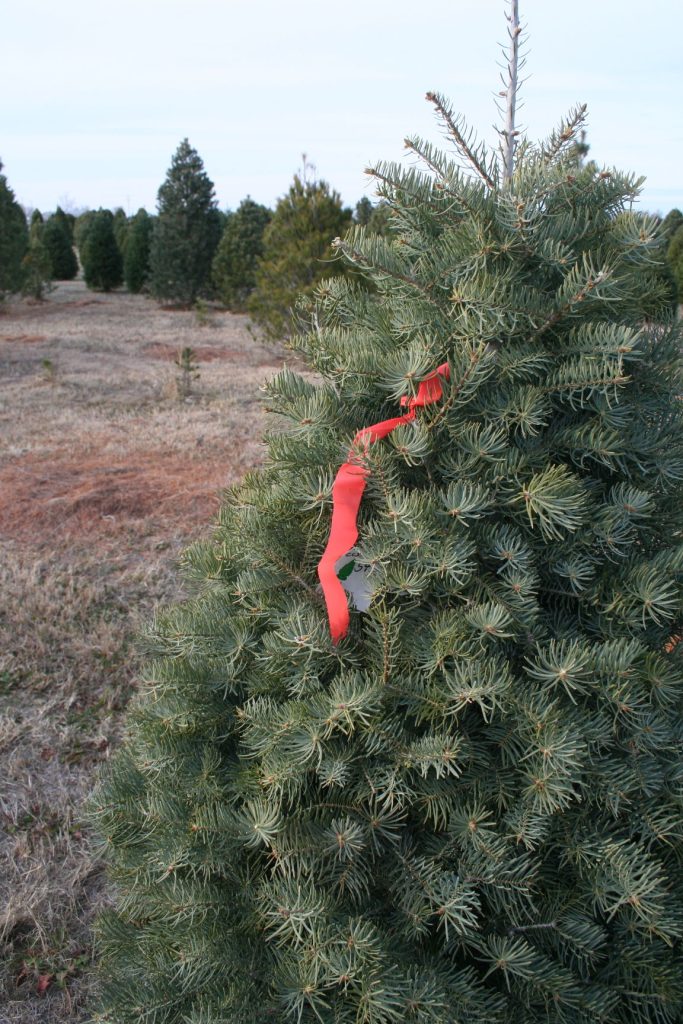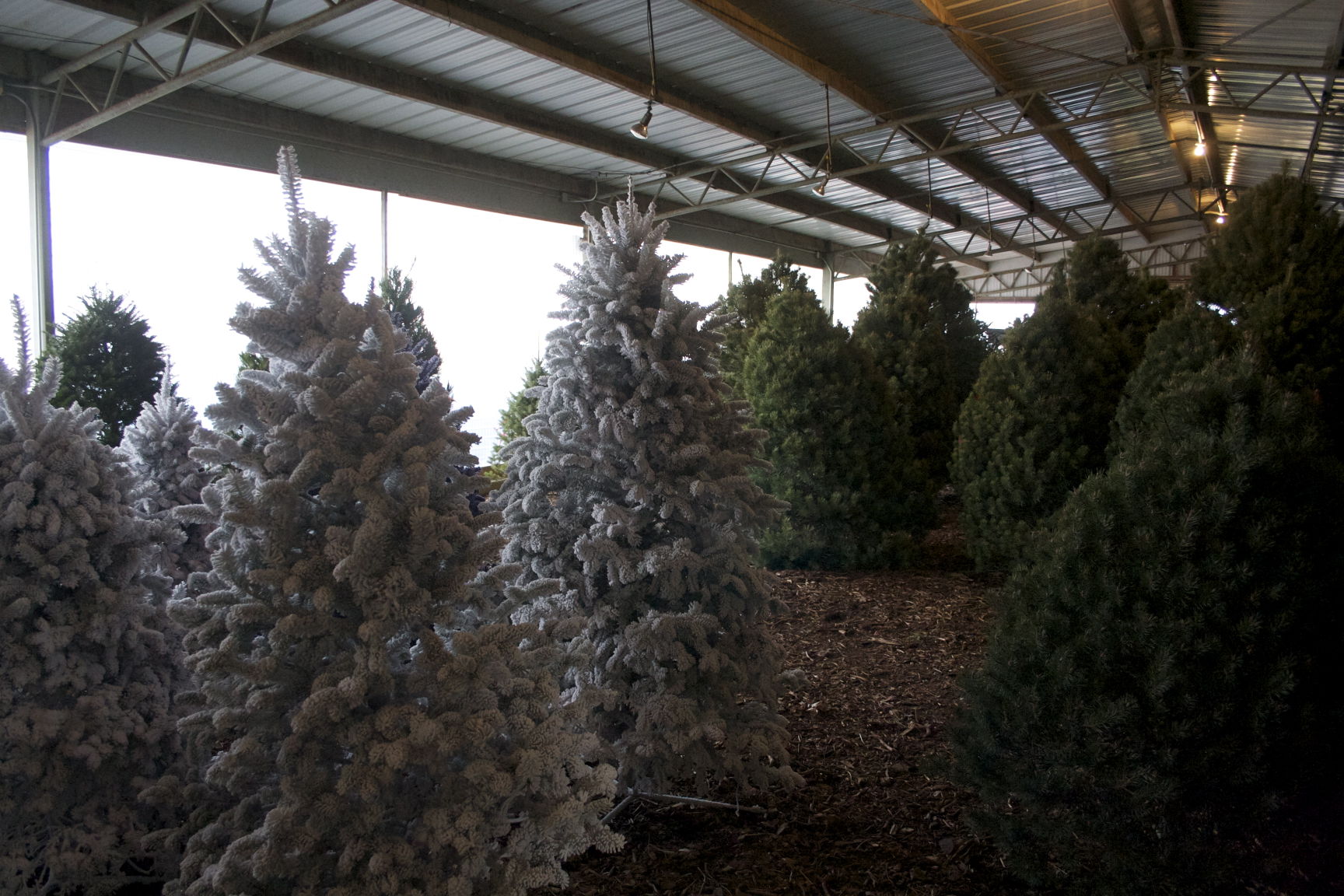Selection tips and care instructions from the National Christmas Tree Association
Selection Tips: What to look for when buying a tree
When purchasing from a retail lot
Measure your space
Be sure you know what size (height and width) you need before heading to the retail lot. Measure the ceiling height in the room where the tree will be displayed. The trees in the field look small when the sky is the ceiling. Don’t overbuy. Measure the width of the area of the room where the tree will be displayed. Most trees on tree farms are trimmed to an 80% taper. So a tree that’s 10′ tall will be 8′ wide at the bottom. A tree that will fit in the room vertically may be entirely too big horizontally.
Think about what type of decorations you will be using
Some species have more open foliage, stiffer branches or longer needles. Research the characteristics of the different species in our tree varieties section, then find a farm near you that has the species you are looking for.
Learn about the different species of trees
If you want the same species you know or have always used, great. If you want to try a different species, browse the tree varieties section of NCTA’s website to become familiar with the species popular in your area before heading to the retail lot.
Safety first
Go to a retail lot that is well-lit and stores trees in a shaded area.
Ask questions about the trees at the lot
Ask the retailer when he/she gets the trees: are they delivered once at the beginning of the season, or several shipments during the season? Often, a tree obtained soon after its arrival on the retail lot will be very fresh because it was cut recently. Also ask the retailer which tree type performs best in your climate. Some species last longer and remain fresh longer than others in different climates.
Do a branch/needle test for freshness
Run a branch through your enclosed hand – the needles should not come off easily. Bend the outer branches – they should be pliable. If they are brittle and snap easily, the tree is too dry.
Look for other indicators of dryness or deterioration
Indicators might include: excessive needle loss, discolored foliage, musty odor, needle pliability, and wrinkled bark. A good rule-of-thumb is, when in doubt about the freshness of a tree, select another one. If none of the trees on the lot look fresh, go to another lot.
Recycling your tree
Ask the retailer about recycling Christmas Trees in your community.

What to Expect at a Choose & Cut Farm
Be aware of possible farm hazards
Most tree farms keep their fields very well groomed, but there are some things that are beyond the farmer’s control. Be careful of fire-ant mounds, tree stumps, an occasional blackberry vine, uneven ground and sharp saws.
Sign up for HPJ Insights
Our weekly newsletter delivers the latest news straight to your inbox including breaking news, our exclusive columns and much more.
Go to the farm prepared for a day in the country
Wear comfortable shoes and old clothes. Bring rain gear if the weather is threatening. The “cutter downers” and the “loader uppers” should also have gloves. Don’t forget the camera. It’s best to leave the family dog at home (many farms will prohibit pets). But, if a pet is allowed and must come along; keep him on a leash at all times. Please don’t let him “mark” other people’s trees.
Equipment to bring
Saws are usually provided by the farm operator. Check ahead of time to double check if you need to bring any supplies.
Pricing
Some farms measure and price trees individually, others sell them by the foot. Ask about the pricing policy before heading out in the field.
Tree size
Head out to the field and select the tree that fits your predetermined needs. Check the trunk to be sure that it is sufficiently straight. Keep in mind that pines will usually have, at least, some crook in their trunks. Also check that the tree has a sufficiently long handle to accommodate your stand.
Needles
In the fall of the year ALL conifers drop or shed a certain portion of their oldest needles. This is a normal part of the life cycle of the tree and occurs because the tree is preparing itself for winter. Most farms provide shaking or blowing services so that you will depart with a perfectly clean tree.
Cutting your tree down
Cutting the tree is easiest as a two person project. The “cutter downer” usually lies on the ground. While the helper holds the bottom limbs up. While the cut is being made, the helper should tug on the tree lightly to ensure that the saw kerf remains open and the saw does not bind. The tugging force should be applied to the side of the tree opposite the cut. In the case of the Leylands, the cut is best made by an attendant at the farm using a chain saw. A back cut should be made first with the final cut coming from the opposite side.
Transportation
Bring the tree to the processing area where it will be cleaned and netted. Netting makes transporting and handling the tree substantially easier.
Now you’re ready to load up and head home to decorate your Real Christmas Tree.
Follow NCTA’s tips for caring for a Real Christmas Tree, and keep in mind that the freshness of a tree you just cut is greater than that of one from a retail lot. Trees from a Choose-and-Cut farm won’t absorb as much water initially as other trees because it has not had time to dry out, unless you don’t put it into a water holding stand right away.
How to Care for Your Farm-Grown Christmas Tree
Use lots of water
When a Christmas tree is cut, more than half its weight is water. With proper care, you can maintain the quality of your tree.
Below are a number of tips on caring for your tree:
- Displaying trees in water in a traditional reservoir type stand is the most effective way of maintaining their freshness and minimizing needle loss problems.
- To display the trees indoors, use a stand with an adequate water holding capacity for the tree. As a general rule, stands should provide 1 quart of water per inch of stem diameter. Devices are available that help maintain a constant water level in the stand.
- Use a stand that fits your tree. Avoid whittling the sides of the trunk down to fit a stand. The outer layers of wood are the most efficient in taking up water and should not be removed.
- Make a fresh cut to remove about a 1/2-inch thick disk of wood from the base of the trunk before putting the tree in the stand. Make the cut perpendicular to the stem axis. Don’t cut the trunk at an angle, or into a v-shape, which makes it far more difficult to hold the tree in the stand and also reduces the amount of water available to the tree.
- Drilling a hole in the base of the trunk does NOT improve water uptake.
- Once home, place the tree in water as soon as possible. Most species can go 6 to 8 hours after cutting the trunk and still take up water. Don’t bruise the cut surface or get it dirty. If needed, trees can be temporarily stored for several days in a cool location. Place the freshly cut trunk in a bucket that is kept full of water.
- The temperature of the water used to fill the stand is not important and does not affect water uptake.
- Check the stand daily to make sure that the level of water does not go below the base of the tree. With many stands, there can still be water in the stand even though the base of the tree is no longer submerged in water.
- Keep trees away from major sources of heat (fireplaces, heaters, heat vents, direct sunlight). Lowering the room temperature will slow the drying process, resulting in less water consumption each day.
- Use of lights that produce low heat, such as miniature lights, will reduce drying of the tree.
- Always inspect light sets prior to placing them on the tree. If worn, replace with a new set.
- Do not overload electrical circuits.
- Always turn off the tree lights when leaving the house or when going to bed.
- Monitor the tree for freshness. After Christmas or if the tree is very dry, remove it from the house.
- Visit the Tree Recycling page to find a recycling program near you.
- Never burn any part of a Christmas tree in a wood stove or fireplace.
Prepared by Dr. Gary Chastagner and Dr. Eric Hinesley; edited by the National Christmas Tree Association
If you get a tree with the roots attached, either in a pot or burlap, follow these suggested tree care tips:
- The adaptability of the species should be considered. Many species are shipped outside of their natural area and may not be adaptable to other areas. Check with a reliable nursery or extension forester.
- Keep in mind that Living Trees are VERY heavy and bulky. A six foot tall balled and burlapped tree will weigh as much as 250 pounds.
- The tree should be stored in an unheated, sheltered area such as a garage or porch, out of the wind and sun. Do not expose the tree to freezing temperatures at any time.
- The tree will need adequate water. The root ball or soil should be kept slightly damp but not flooded. Wrap the root ball of a balled tree in plastic or place in a tub while it is in the house.
- Live trees may be decorated, but with care. If lights are used, they must not give off any heat.
- Do not remove the tree directly from a warm house out into freezing temperatures. Instead, move to a sheltered area first for several days.
- If the ground is unfrozen, the tree may be replanted. The spot to be dug should be mulched to prevent freezing. Plant as soon as possible.
- Do not remove the burlap and strapping (unless it is plastic). This keeps the root ball solid and secure. In the instance of a plastic cover, cut the cord and roll down the plastic at least half way prior to planting. Tap the tree container of a potted tree and remove prior to planting. Do not attempt to remove soil from the root system. Earth removed from the original hole should be back-filled around the root ball. Mulch heavily over the top of the planted root ball to prevent it from freezing. Water only as needed: a flooded tree may not survive.
- Stake the trees to prevent wind tipping or damage during the first growing season.
For more information, call or email the National Christmas Tree Association: (800) 975-5920 │ [email protected]



